Experimental and Numerical Study of the Behavior of Concrete-Filled High-Strength Steel Tube Columns with Large D/t Ratio under Axial Compression
Abstract
:1. Introduction
2. Experimental Program and Results
2.1. Specimen Designs
2.2. Test Materials
2.3. Test Setup and Loading Program
2.4. Axial Compression Test and Results
2.4.1. Failure Modes
2.4.2. Load–Displacement Curve
2.4.3. Load–Strain Curves
3. Finite Element Modelling and Verification
3.1. Finite Element Modelling
3.1.1. Simulation Method
3.1.2. Material Properties
- (1)
- Q690 high-strength steel
- (2)
- Core concrete
3.1.3. Loading Methods and Boundary Conditions
3.2. Validation of FE Modelling
3.2.1. Failure Modes
3.2.2. Load–Displacement Curves and Axial Capacity
4. Analysis and Discussion
4.1. Compressive Behavior
4.2. Numerical Parametric Studies
4.2.1. Effect of D/t Ratio
4.2.2. Effect of Concrete Compressive Strength
4.2.3. Effect of Steel Yield Strength
4.2.4. Effect of Confinement Effect Coefficient
5. Evaluation of Existing Design Methods and Development of New Design Approaches
5.1. Existing Design Methods
5.1.1. Eurocode 4 (EC4)
5.1.2. GB 50936-2014
5.1.3. AIJ-97
5.2. New Design Proposal
5.3. Comparison with the Existing Design Methods
6. Conclusions
- The failure mode of the CFHST stub column is mainly shear failure, which is because the local buckling of the steel tube weakens the confinement effect of the steel tube on concrete, resulting in brittle failure of concrete.
- The contact pressure shows an obvious stable stage at the BC stage of the CFHST column, which is because in the HS steel tube it is difficult to effectively confine the lateral deformation of concrete after yielding and local failure. At the end of this stage, the contributions of steel tube and concrete to the compressive capacity are 32% and 68%, respectively.
- The influence of key parameters on the axial compressive capacity of CFHST short columns is studied by numerical analysis, and the compressive strength of core concrete has the most obvious effect on the post-peak degradation of the N-ε curve. As the compressive strength of the concrete cylinder increases from 40 MPa to 100 MPa, the peak load increases by 80.48%.
- The accuracy of the new design proposal in predicting the peak load of CFHST short columns is verified by using 88 FE results and 15 test results, and it is proved that the peak load of CFHST columns predicted by the new design proposal, EC4, GB50936-2014, and AIJ-97 codes is conservative, with an average value of 1.00, 0.90, 0.97, and 0.84, respectively.
Author Contributions
Funding
Data Availability Statement
Conflicts of Interest
References
- Zhang, Z.; Wu, X.; Hu, G.; Sun, Q. Numerical study on triaxial compressive behavior of engineered cementitious composites confined by circular steel tubes. Constr. Build. Mater. 2022, 345, 128285. [Google Scholar] [CrossRef]
- Yu, P.; Ren, Z.; Yun, W.; Zhao, Y.; Xu, J. Performance of Bolt-Welded CFST Short Columns with Different Initial Imperfections: Experimental and Numerical Studies. Buildings 2022, 12, 1352. [Google Scholar] [CrossRef]
- Wang, Y.; Gao, S.; Xu, Y.; Li, F. Lateral Impact Response of Concrete-Filled Square Steel Tubes with Local Defects. Buildings 2022, 12, 996. [Google Scholar] [CrossRef]
- Chen, Z.; Dong, S.; Du, Y. Experimental study and numerical analysis on seismic performance of FRP confined high-strength rectangular concrete-filled steel tube columns. Thin-Walled Struct. 2021, 162, 107560. [Google Scholar] [CrossRef]
- Chen, Z.; Ning, F.; Song, C.; Liang, Y. Study on axial compression bearing capacity of novel concrete-filled square steel tube columns. J. Build. Eng. 2022, 51, 104298. [Google Scholar]
- Azevedo, V.; Lima, L.; Vellasco, P.; Tavares, M. Experimental investigation on recycled aggregate concrete filled steel tubular stub columns under axial compression. J. Constr. Steel Res. 2021, 187, 106930. [Google Scholar]
- Yu, C.; Tong, J.; Tong, G. Behavior and design of slender concrete-filled wide rectangular steel tubular columns under axial compression. Structures 2021, 33, 3137. [Google Scholar] [CrossRef]
- Qiao, Q.; Li, J.; Yang, Z.; Cao, W.; Yang, J.; Zhang, W. Axial compressive behavior of concrete filled stainless-carbon steel tube columns: Experimental investigation. J. Build. Eng. 2021, 42, 102460. [Google Scholar] [CrossRef]
- Khan, M.; Uy, B.; Tao, Z.; Mashiri, F. Concentrically loaded slender square hollow and composite columns incorporating high strength properties. Eng. Struct. 2017, 131, 69. [Google Scholar] [CrossRef]
- Yan, Y.; Xu, L.; Li, B.; Chi, Y.; Yu, M.; Zhou, K.; Song, Y. Axial behavior of ultra-high performance concrete (UHPC) filled stocky steel tubes with square sections. J. Constr. Steel Res. 2019, 158, 417. [Google Scholar] [CrossRef]
- Uy, B.; Mursi, M.; Tan, A. Strength of slender concrete filled columns fabricated with high strength structural steel. In ICASS ’02 Third International Conference on Advances in Steel Structures; Elsevier: Hong Kong, China, 2002; p. 575. [Google Scholar]
- Sakino, K.; Nakahara, H.; Morino, S.; Nishiyama, I. Behavior of centrally loaded concrete-filled steel-tube short columns. J. Struct. Eng. 2004, 130, 180. [Google Scholar] [CrossRef]
- Aslani, F.; Uy, B.; Tao, Z.; Mashiri, F. Behaviour and design of composite columns incorporating compact high-strength steel plates. J. Constr. Steel Res. 2015, 107, 94. [Google Scholar] [CrossRef]
- Liao, J.; Li, Y.; Yi, O.; Zeng, J. Axial compression tests on elliptical high strength steel tubes filled with self-compacting concrete of different mix proportions. J. Build. Eng. 2021, 40, 102678. [Google Scholar] [CrossRef]
- Wang, X.; Fan, F.; Lai, J. Strength behavior of circular concrete-filled steel tube stub columns under axial compression: A review. Constr. Build. Mater. 2022, 322, 126144. [Google Scholar] [CrossRef]
- Tu, C.; Shi, Y.; Dong, L.; Wang, W.; Ban, H. Behavior and general design method of concrete-filled high-strength steel tube (CFHST) columns. Eng. Struct. 2021, 243, 112506. [Google Scholar] [CrossRef]
- GB 50936-2014; Technical Code for Concrete Filled Steel Tubular Structures. China Building Industry Press: Beijing, China, 2014. (In Chinese)
- Eurocode 4, Design of Composite Steel and Concrete Structures-Part 1-1: General Rules and Rules for Buildings; European Committee for Standardization: Brussels, Belgium, 2004.
- ACI 318-05; Building Code Requirements for Structural Concrete and Commentary. American Concrete Institute: Farmington Hills, MI, USA; Detroit, MI, USA, 2005.
- AISC 360-16; Specification for Structural Steel Buildings. American Institute of Steel Construction: Chicago, IL, USA, 2016.
- GB/T 19879-2015; Steel Plate for Building Structure. China Building Industry Press: Beijing, China, 2015. (In Chinese)
- Han, L. Concrete Filled Steel Tubular Structures-Theory and Practice, 3rd ed.; Science Press: Beijing, China, 2016. (In Chinese) [Google Scholar]
- Feng, P.; Qiang, H.; Ye, L. Discussion and definition on yield points of materials, members and structures. Eng. Mech. 2017, 34, 36. (In Chinese) [Google Scholar]
- Liu, J.; Zhou, X. Behavior and strength of tubed RC stub columns under axial compression. J. Constr. Steel Res. 2010, 66, 28. [Google Scholar] [CrossRef]
- Mander, J.; Priestley, M.; Park, R. Theroetical stress-strain model for confined concrete. J. Struct. Eng. 1988, 114, 1804. [Google Scholar] [CrossRef] [Green Version]
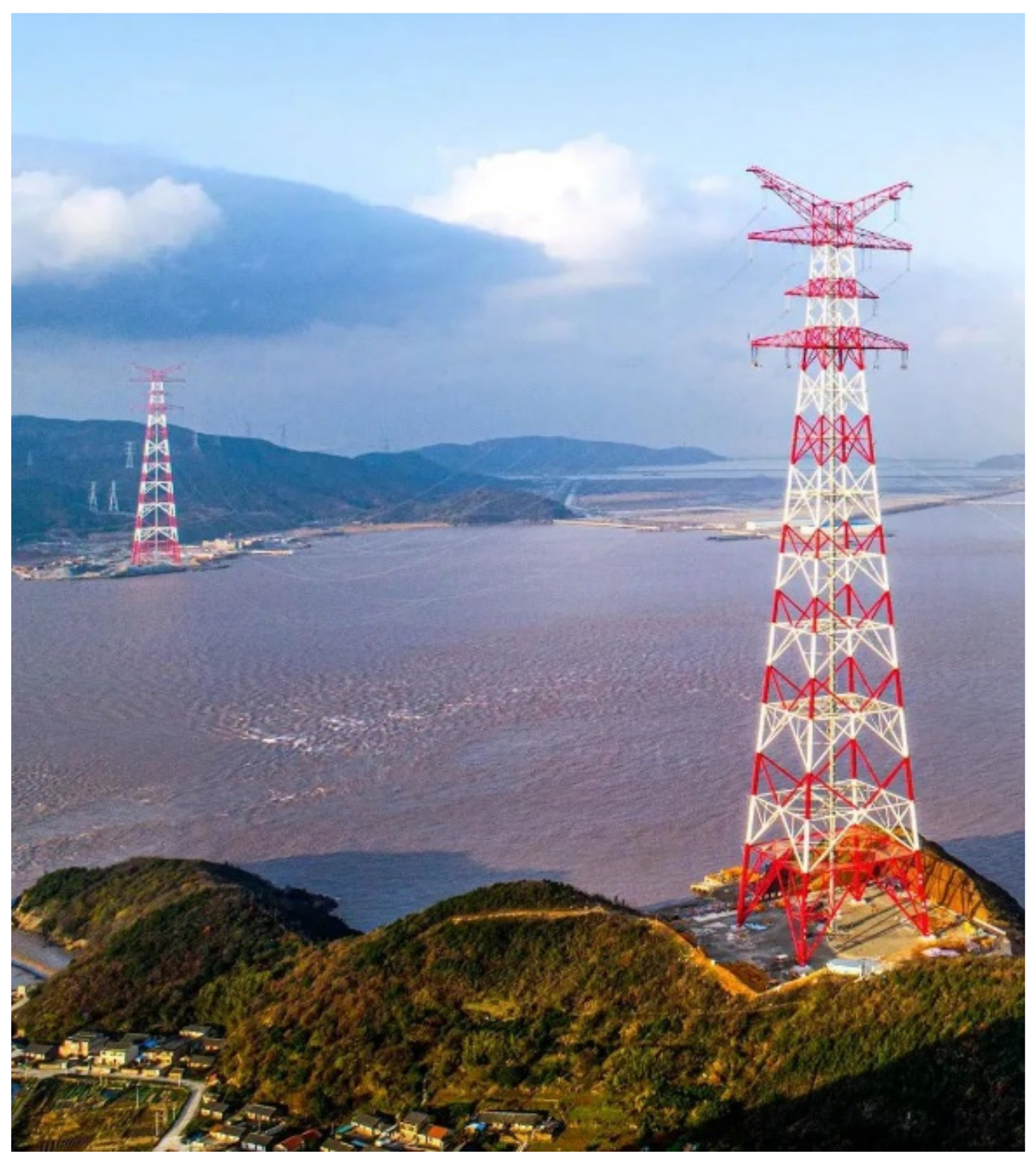
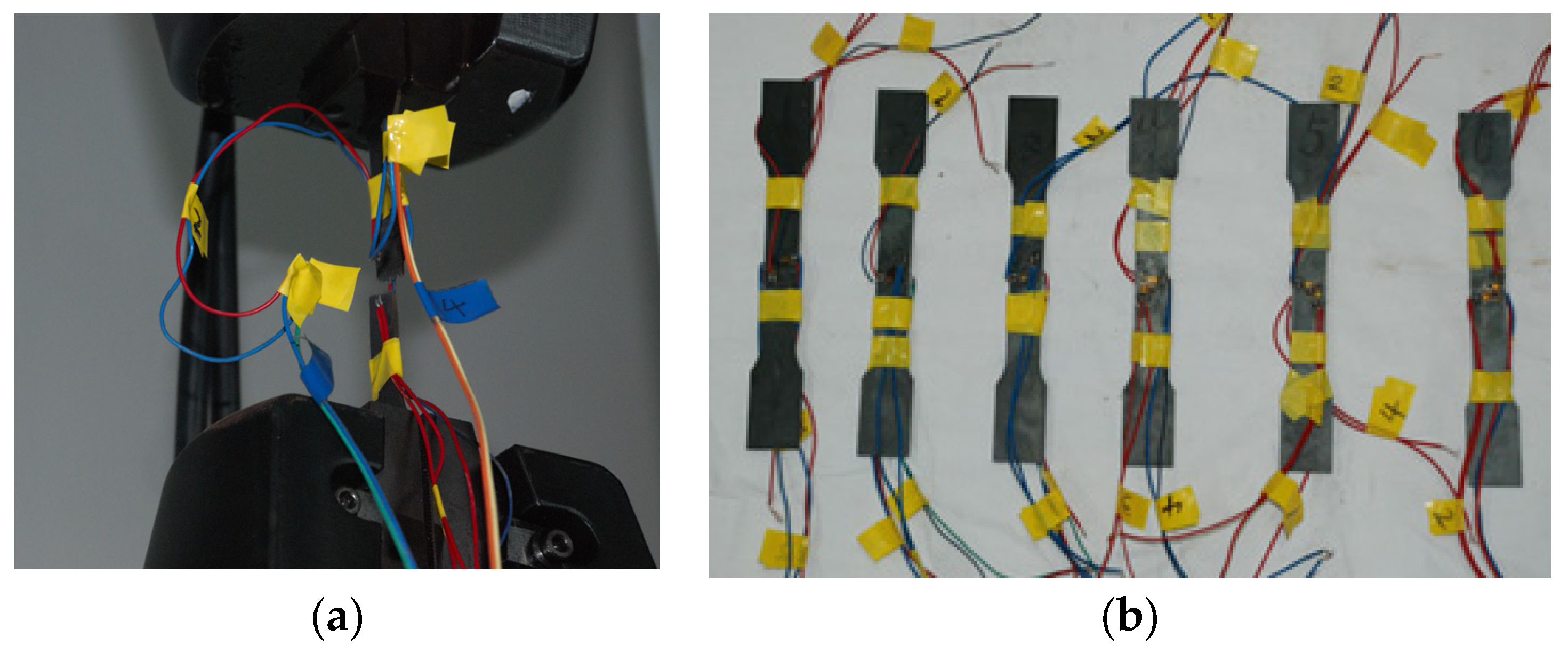

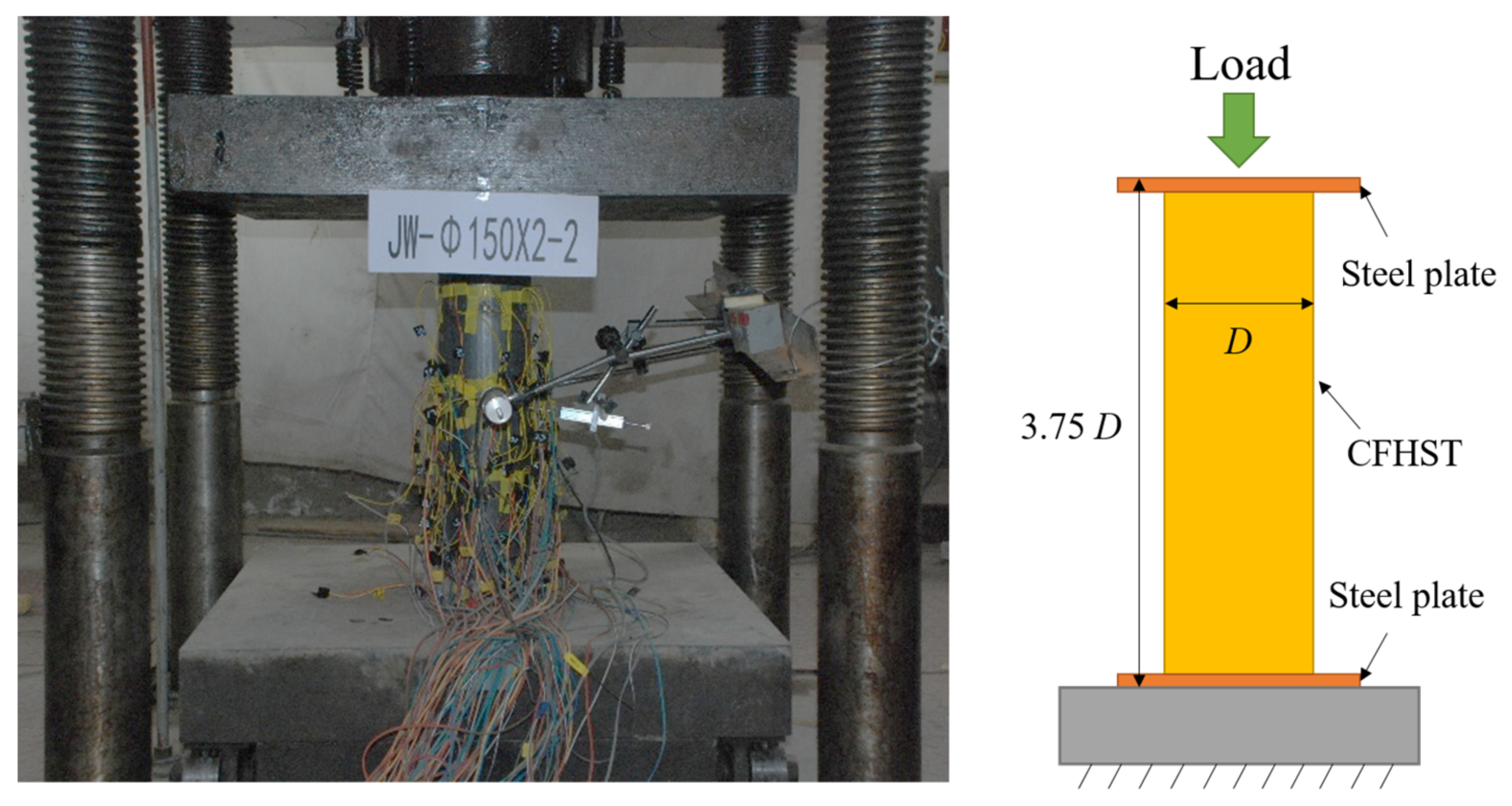

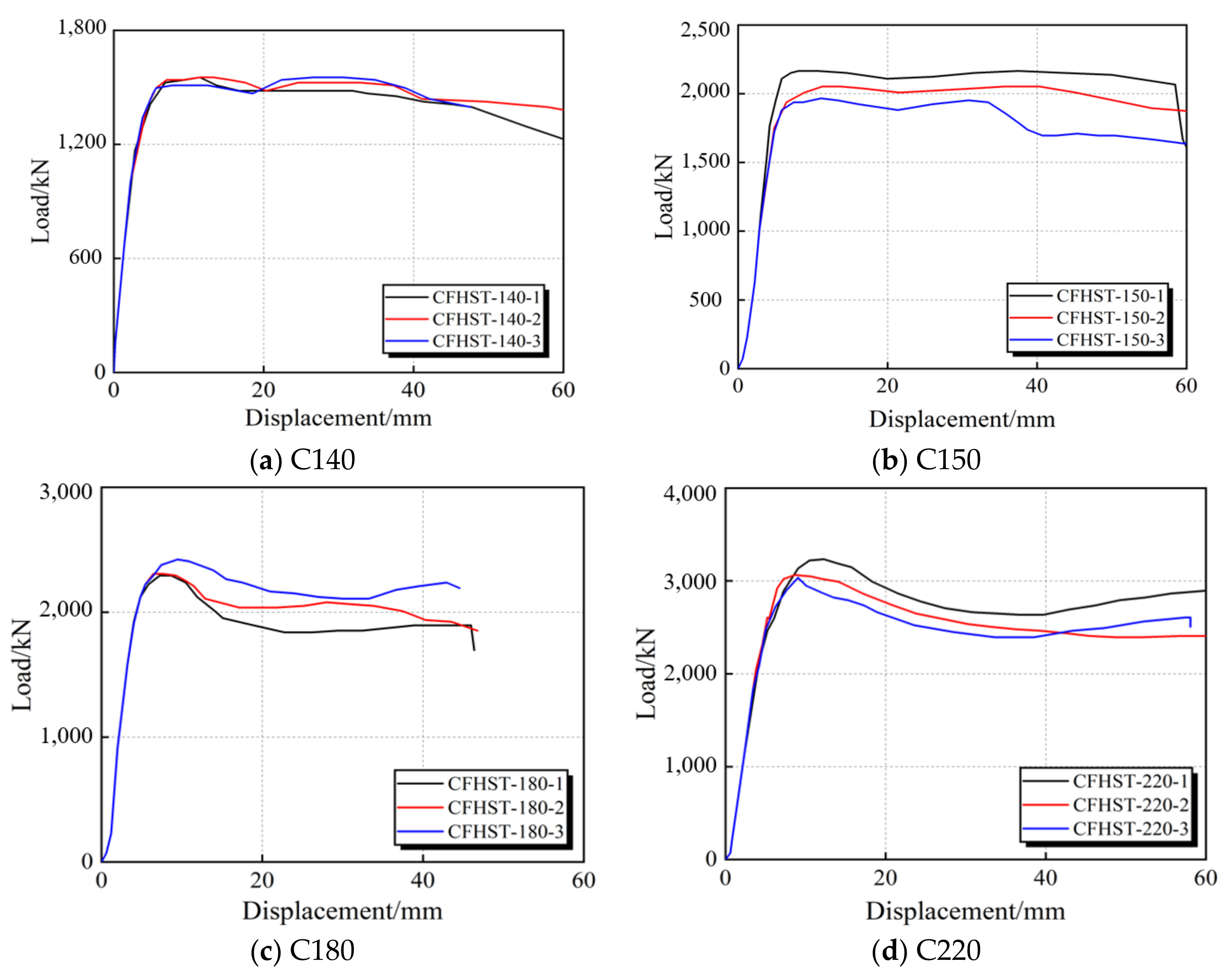
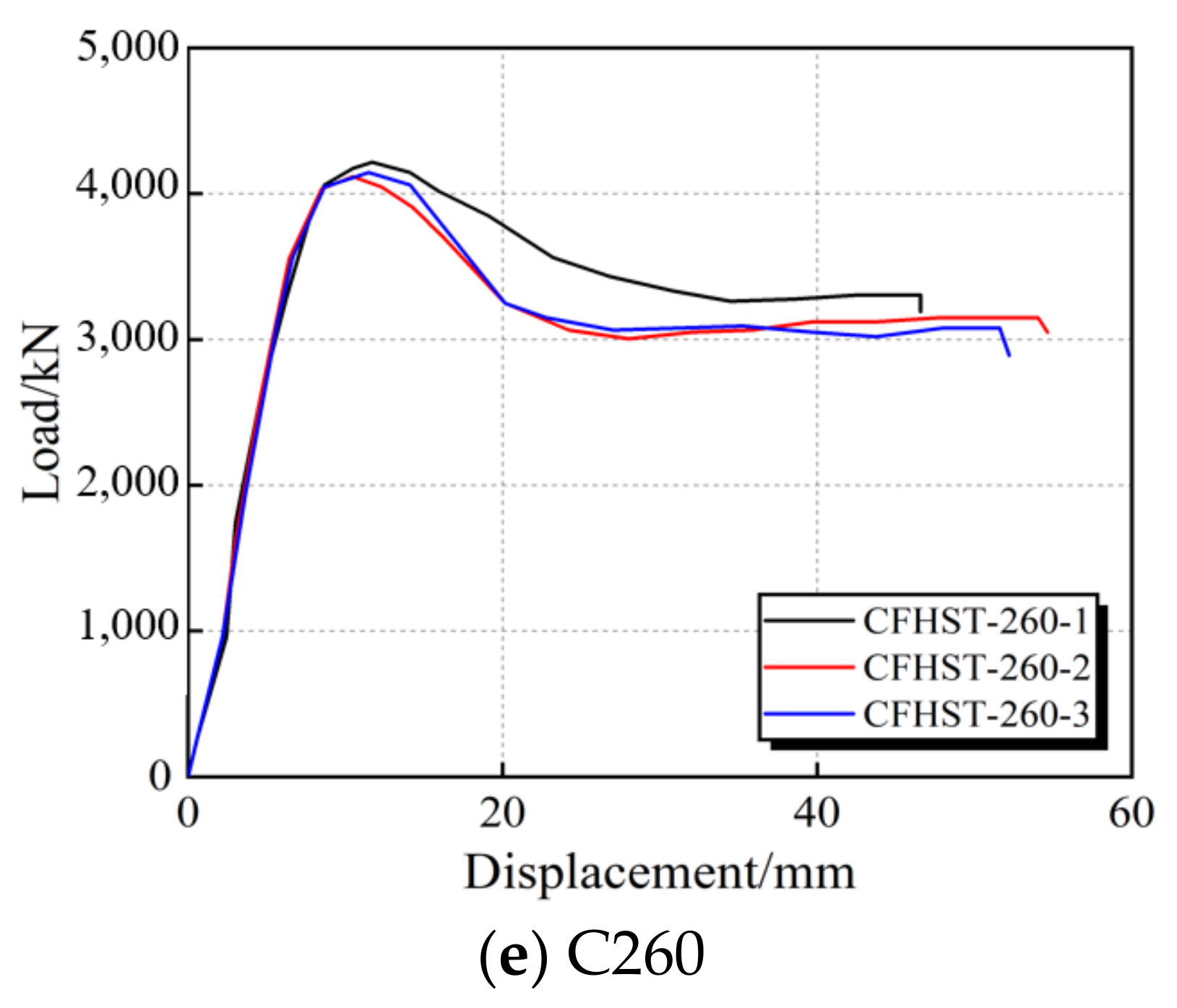


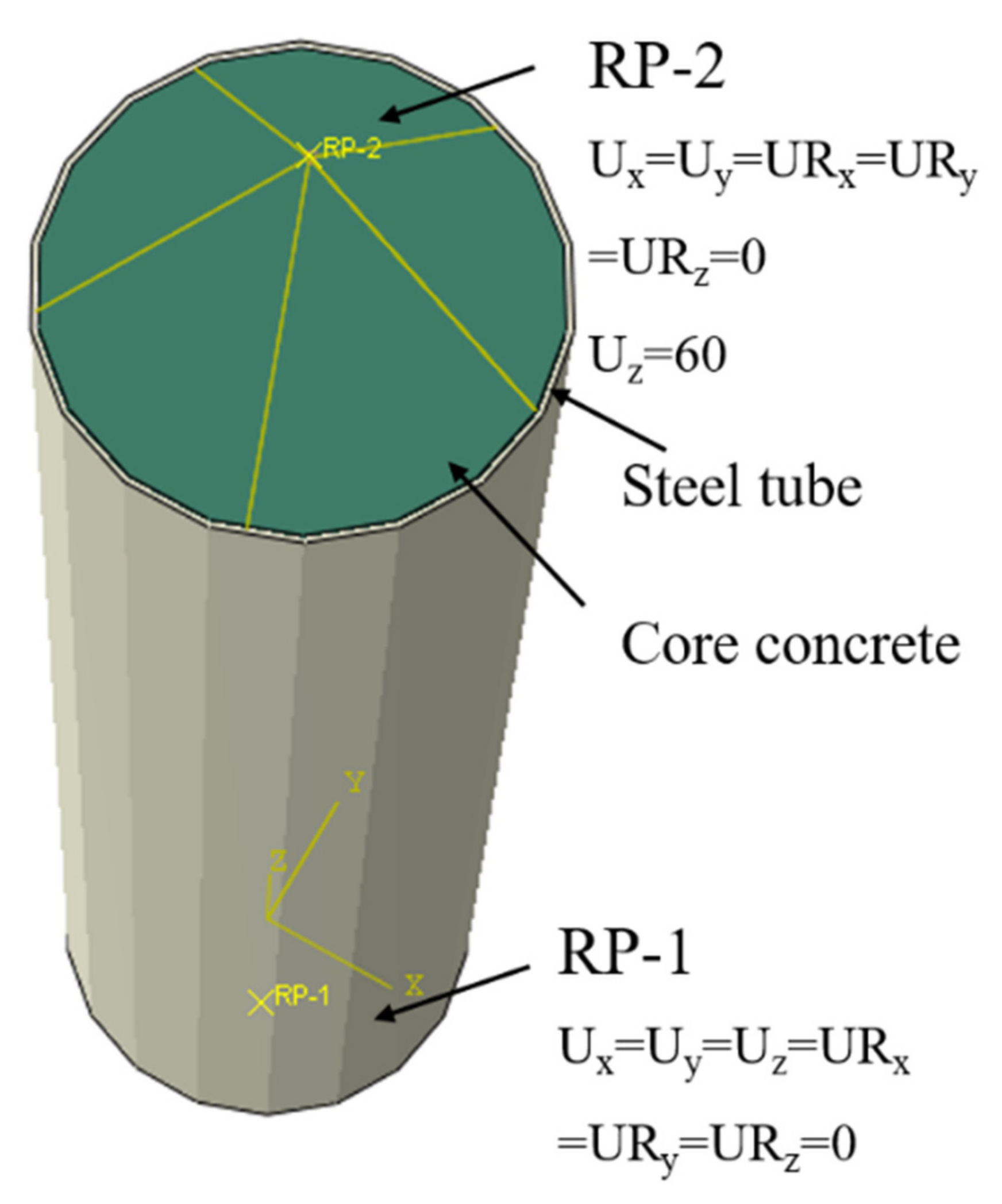

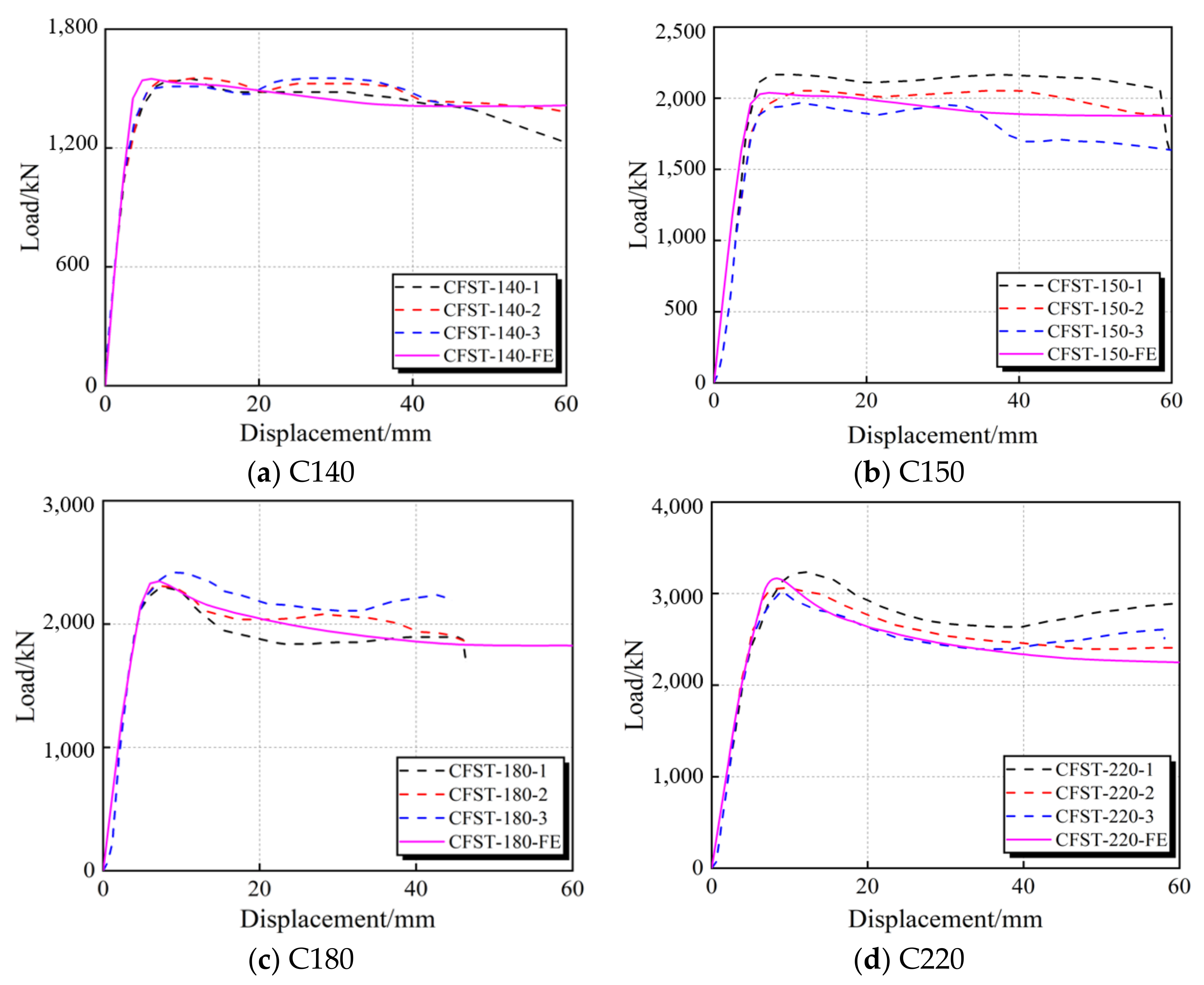

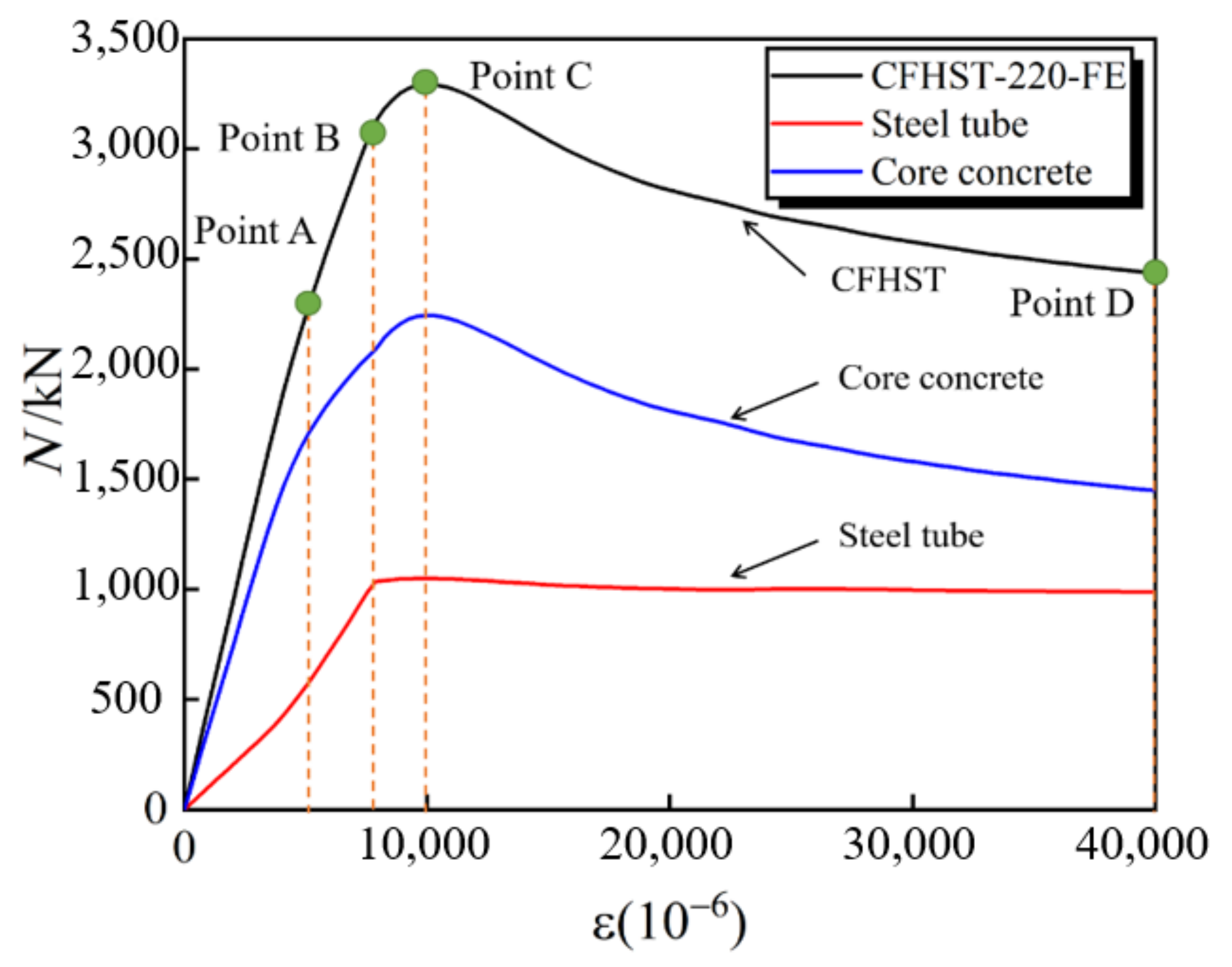
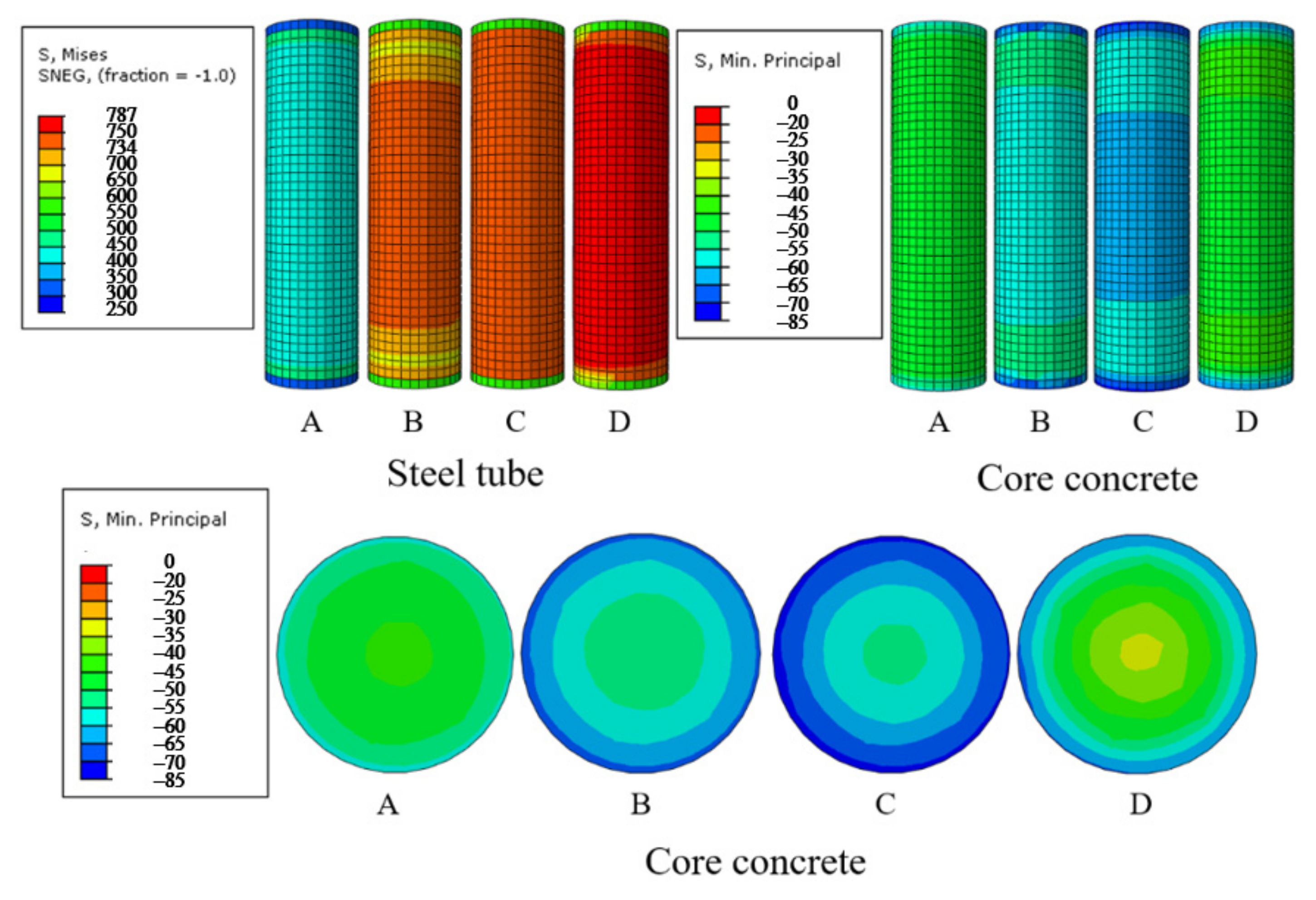
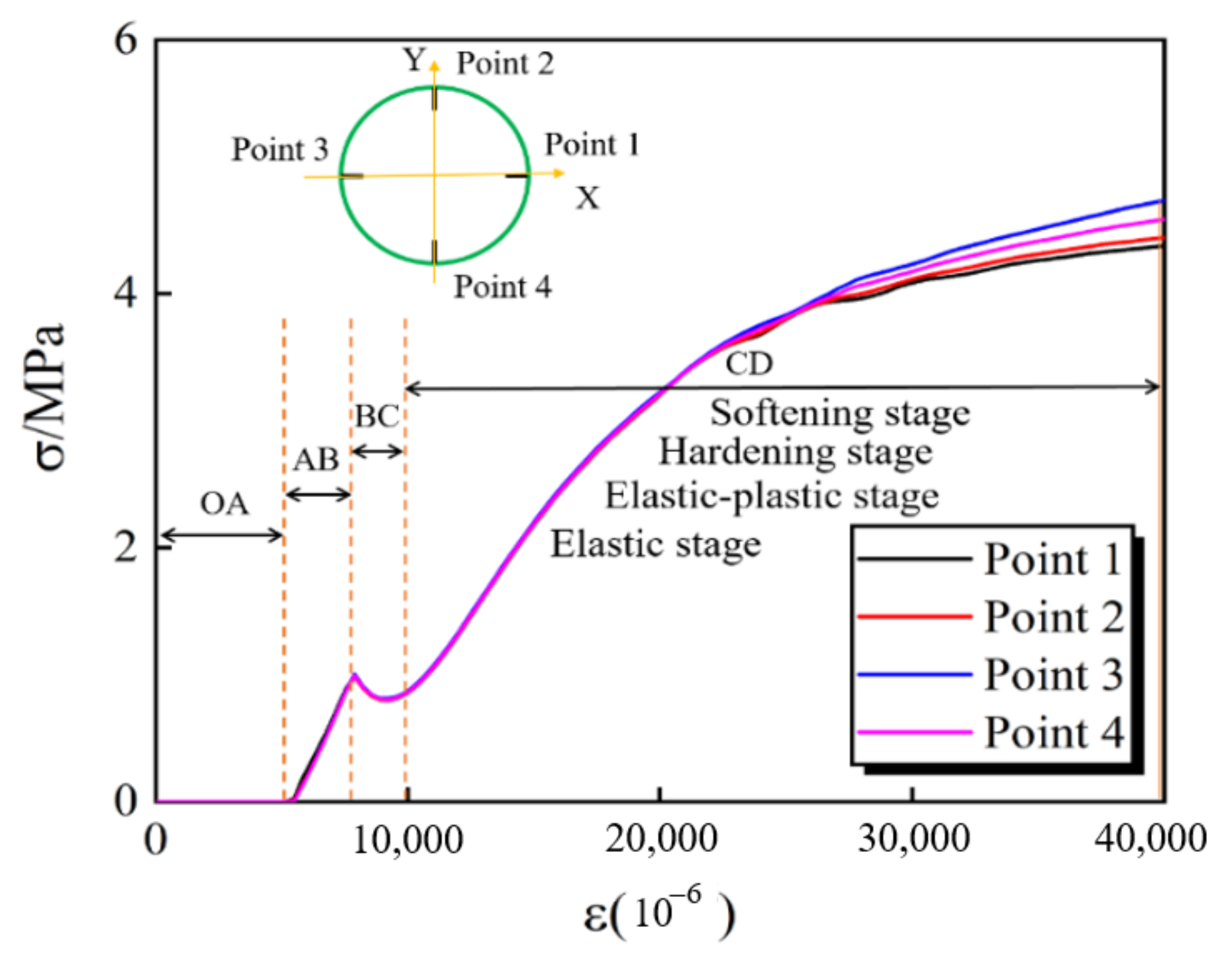


| Group | Specimens | D/mm | t/mm | L/mm | D/t Ratios | Steel Grade | Concrete Grade |
|---|---|---|---|---|---|---|---|
| CFHST-140 | CFHST-140-1 | 141.42 | 2.35 | 525 | 60.18 | Q690 | C50 |
| CFHST-140-2 | 141.44 | 2.22 | 525 | 63.71 | |||
| CFHST-140-3 | 140.84 | 2.37 | 525 | 59.43 | |||
| CFHST-150 | CFHST-150-1 | 151.05 | 2.98 | 562.5 | 50.69 | Q690 | C50 |
| CFHST-150-2 | 150.62 | 3.04 | 562.5 | 49.55 | |||
| CFHST-150-3 | 151.5 | 2.98 | 562.5 | 50.84 | |||
| CFHST-180 | CFHST-180-1 | 182.50 | 2.27 | 675 | 80.40 | Q690 | C50 |
| CFHST-180-2 | 181.80 | 2.17 | 675 | 83.78 | |||
| CFHST-180-3 | 181.15 | 2.27 | 675 | 79.80 | |||
| CFHST-220 | CFHST-220-1 | 220.00 | 2.13 | 825 | 103.29 | Q690 | C50 |
| CFHST-220-2 | 221.50 | 2.17 | 825 | 102.07 | |||
| CFHST-220-3 | 220.97 | 2.13 | 825 | 103.74 | |||
| CFHST-260 | CFHST-260-1 | 261.70 | 2.13 | 975 | 122.86 | Q690 | C50 |
| CFHST-260-2 | 261.90 | 2.11 | 975 | 124.12 | |||
| CFHST-260-3 | 262.00 | 2.16 | 975 | 121.30 |
| Group | t/mm | fy/MPa | fu/MPa | fu/fy | Es/GPa | μ |
|---|---|---|---|---|---|---|
| S-1 | 2 | 734 | 787 | 0.93 | 200.7 | 0.24 |
| S-2 | 3 | 691 | 757 | 0.91 | 200.6 | 0.25 |
| Concrete Grade | Weight/[kg/m3] | |||||
|---|---|---|---|---|---|---|
| Fly Ash | Water | Cement | Sand | Gravel | Water Reducer | |
| C50 | 80 | 170 | 360 | 693 | 1084 | 13.2 |
| Specimen | D/mm | t/mm | D/t | /MPa | /MPa | /kN | /kN | |
|---|---|---|---|---|---|---|---|---|
| CFHST-140 | 140 | 2.31 | 60.61 | 734 | 50.4 | 1564 | 1587 | 0.99 |
| CFHST-150 | 150 | 3.00 | 50 | 691 | 50.4 | 2057 | 2056 | 1.00 |
| CFHST-180 | 180 | 2.24 | 80.36 | 734 | 50.4 | 2330 | 2389 | 0.98 |
| CFHST-220 | 220 | 2.14 | 102.80 | 734 | 50.4 | 3096 | 3293 | 0.94 |
| CFHST-260 | 260 | 2.13 | 122.07 | 734 | 50.4 | 4207 | 4037 | 1.04 |
| All | Mean | 0.99 | ||||||
| COV | 0.001 |
| No. | Models | D (mm) | t (mm) | D/t | L (mm) | L/D | fc (MPa) | fy (MPa) | ζ | Nu (kN) |
|---|---|---|---|---|---|---|---|---|---|---|
| 1 | C1 | 220 | 1.10 | 200 | 825 | 3.75 | 40 | 700 | 0.42 | 2715.95 |
| 2 | C2 | 220 | 1.47 | 150 | 825 | 3.75 | 40 | 700 | 0.57 | 2901.08 |
| 3 | C3 | 220 | 2.20 | 100 | 825 | 3.75 | 40 | 700 | 0.86 | 3266.16 |
| 4 | C4 | 220 | 4.40 | 50 | 825 | 3.75 | 40 | 700 | 1.78 | 4401.6 |
| 5 | C5 | 220 | 2.20 | 100 | 825 | 3.75 | 60 | 700 | 0.62 | 4150.09 |
| 6 | C6 | 220 | 2.20 | 100 | 825 | 3.75 | 80 | 700 | 0.48 | 5028.75 |
| 7 | C7 | 220 | 2.20 | 100 | 825 | 3.75 | 100 | 700 | 0.39 | 5894.70 |
| 8 | C8 | 220 | 2.20 | 100 | 825 | 3.75 | 40 | 550 | 0.68 | 2999.99 |
| 9 | C9 | 220 | 2.20 | 100 | 825 | 3.75 | 40 | 460 | 0.57 | 2861.54 |
| 10 | C10 | 220 | 2.20 | 100 | 825 | 3.75 | 40 | 345 | 0.42 | 2688.79 |
| 11 | C11 | 220 | 2.20 | 100 | 825 | 3.75 | 40 | 235 | 0.29 | 2522.84 |
| 12 | C12 | 220 | 0.93 | 220 | 825 | 3.75 | 40 | 700 | 1.12 | 3584.51 |
| No. of Tests:15 No. of FE Models:88 | EC4 | GB 50936-2014 | AIJ-97 | New Design Proposal |
|---|---|---|---|---|
| Mean | 0.90 | 0.97 | 0.84 | 1.00 |
| COV | 0.0032 | 0.0053 | 0.0038 | 0.0049 |
Publisher’s Note: MDPI stays neutral with regard to jurisdictional claims in published maps and institutional affiliations. |
© 2022 by the authors. Licensee MDPI, Basel, Switzerland. This article is an open access article distributed under the terms and conditions of the Creative Commons Attribution (CC BY) license (https://creativecommons.org/licenses/by/4.0/).
Share and Cite
Zhang, Z.; Wang, J.; Sun, Q.; Tian, P.; Wang, J.; Wu, Y.; Li, Y. Experimental and Numerical Study of the Behavior of Concrete-Filled High-Strength Steel Tube Columns with Large D/t Ratio under Axial Compression. Buildings 2022, 12, 1953. https://doi.org/10.3390/buildings12111953
Zhang Z, Wang J, Sun Q, Tian P, Wang J, Wu Y, Li Y. Experimental and Numerical Study of the Behavior of Concrete-Filled High-Strength Steel Tube Columns with Large D/t Ratio under Axial Compression. Buildings. 2022; 12(11):1953. https://doi.org/10.3390/buildings12111953
Chicago/Turabian StyleZhang, Zaiyu, Jiaqi Wang, Qing Sun, Penggang Tian, Jiantao Wang, Yanru Wu, and Yuwei Li. 2022. "Experimental and Numerical Study of the Behavior of Concrete-Filled High-Strength Steel Tube Columns with Large D/t Ratio under Axial Compression" Buildings 12, no. 11: 1953. https://doi.org/10.3390/buildings12111953




